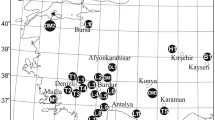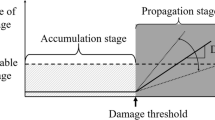Abstract
In Europe, the Wide Wheel abrasion (WWA) test and the Böhme abrasion (BA) test are among the most widely used standard test methods for determining abrasion resistance of natural stones, the former being the reference test method in EN 14157 Standard. However, it is stated in the Annex-A (Informative) of EN 14157 Standard that very limited data are available to provide correlations between these two test methods. To be able to fill this gap, in this study, 25 different natural stones belonging to sedimentary, metamorphic and igneous groups were tested for their abrasion resistance as well as physico-mechanical properties. Also, for a better interpretation of abrasion resistance characteristics of the tested stone materials, relationships between abrasion resistance and physico-mechanical properties were statistically examined. A statistically significant linear correlation (R 2 = 0.85; P value = 0.000) was established between the WWA test and the BA test, which could be used in practice for converting the measured abrasion resistance values from one testing method to another. It was also found that the correlation between these two test methods improved significantly (R 2 = 0.93; P value = 0.001) when relatively high-porosity stone materials (porosity ≥1%) were separately evaluated. Both methods of abrasion resistance employed in the present study showed statistically significant linear correlations with uniaxial compressive strength and Brazilian tensile strength, the former proving to be a more influencing parameter on resistance to abrasion. Also, from the point view of representing actual abrasion mechanism of stone materials in practice, the necessity of simulating multi-directional foot traffic in abrasion testing methods was discussed. In this respect, the reference test method in the EN 14157 Standard was criticized for not fully meeting this requirement. It was also pointed out that the reference method could have some drawbacks when applied to coarse-grained granitic rocks having cleavable minerals such as plagioclase and orthoclase feldspars.















Similar content being viewed by others
References
ASTM C 241-90 (2005) Standard test method for abrasion resistance of stone subjected to foot traffic
ASTM C 503 (2005) Standard specification for marble dimension stone (Exterior)
CNR Fascicolo n. 4 (1953) Norme per l’accettazione dei pietrischi, dei pietrischetti, delle graniglie, delle sabbie e degli additive per costruzioni stradali
EN 14157 (2004) Natural stones-Determination of abrasion resistance
Goktan RM, Emir E (1996) The usability of Rockwell hardness test for the prediction of abrasion resistance in marbles, (In Turkish). Türkiye’de Mermer 46:16–20
Hawk JA, Wilson RD, Tylczak JH, Doğan ÖN (1999) Laboratory abrasive wear tests: investigation of test methods and alloy correlation. Wear 225–229:1031–1042
Iphar M, Göktan RM (2006) Prediction of abrasion resistance of marbles using adaptive neuro-fuzzy inference system (ANFIS). Proceedings of the Turkish 5th Marble and Natural Stone Symposium. Afyonkarahisar, Turkey (In Turkish), pp 171–182
ISRM (2007) The complete ISRM suggested methods for rock characterization, testing and monitoring: 1974–2006. In: Ulusay R, JA Hudson (eds) Suggested methods prepared by the commission on testing methods, International Society for Rock Mechanics, Compilation arranged by the ISRM Turkish National Group, Ankara, Turkey, 628 p
Karaca Z, Deliormanlı AH, Elci H, Pamukcu C (2010) Effect of freeze–thaw process on the abrasion loss value of stones. Int J Rock Mech Min Sci 47:1207–1211
Kılıç A, Teymen A (2008) Determination of mechanical properties of rocks using simple methods. Bull Eng Geol Envrion 67:237–244
Marini P, Bellopede R, Perino L, Regibus CD (2011) Optimisation of an abrasion resistance test method on natural stones. Bull Eng Geol Environ 70:133–138
Marradi A, Secchiari L, Lezzerini M (2008) The qualification of materials for their application in road stone pavements. Proceedings of the Second International Congress on Dimension Stones, Carrara, Italy, pp 225–235
Podra P, Andersson S (1999) Simulating sliding wear with finite element method. Tribol Int 32:71–78
TS EN 1936 (2001) Natural stone test methods-Determination of real density and apparent density, and of total and open porosity
Yavuz AB, Turk N, Koca MY (2005) Material properties of the Menderes massif marbles from SW Turkey. Eng Geol 82:91–106
Yavuz H, Ugur I, Demirdag S (2008) Abrasion resistance of carbonate rocks used in dimension stone industry and correlations between abrasion and rock properties. Int J Rock Mech Min Sci 45:260–267
Author information
Authors and Affiliations
Corresponding author
Rights and permissions
About this article
Cite this article
Karaca, Z., Günes Yılmaz, N. & Goktan, R.M. Considerations on the European Standard EN 14157 Test Methods: Abrasion Resistance of Natural Stones Used for Flooring in Buildings. Rock Mech Rock Eng 45, 103–111 (2012). https://doi.org/10.1007/s00603-011-0190-1
Received:
Accepted:
Published:
Issue Date:
DOI: https://doi.org/10.1007/s00603-011-0190-1




